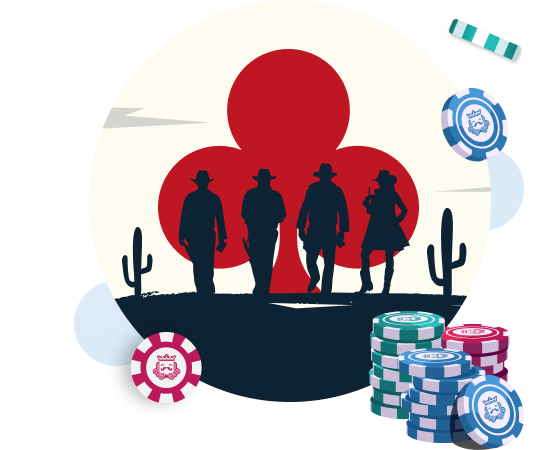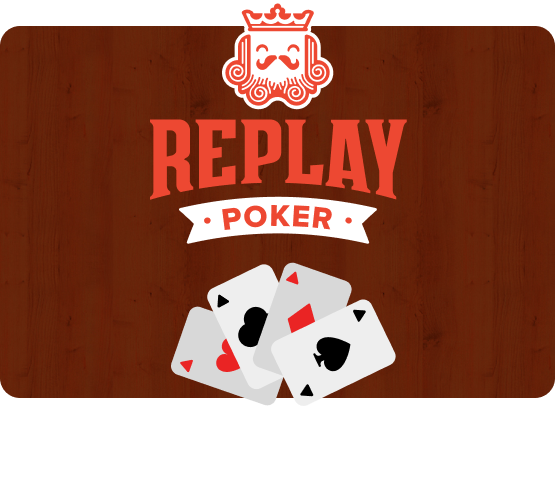Learn How to Play Poker Online
Why is Replay Poker the perfect place to learn how to play poker?
The games at our site are 100% free to play, yet feature a competitive player base who take the game seriously. Those just here to blow off steam, shoving all-in on every hand, are actively discouraged by our professional player support team. The result is a gameplay experience that mirrors the standard you’d find at a real money online poker site online, without the possibility of ever losing money.
Hit the button below if you’re ready to get started, then read on for our guide on how to become a kickass poker player in just five simple steps.
Sign up
Become Familiar With the Rules
Check out our guide to poker rules to get familiar with the basics of poker, as it’s crucial to know which hands beat which other hands, for example, or what blinds are, and how betting rounds work.
These fundamentals apply to almost every form of poker there is, and never change, so the good news is that you’ll only need to learn these basics once. Plus, when playing online it’s easy to bookmark a webpage and leave it open while you play, so if you need a reminder of the hierarchy of poker hands we’d recommend adding this page to your favorites.
As Texas Hold’em is the most widely played poker game in the world, it’s a great game to start with. In fact, we’ll concentrate on Texas Hold’em here as we show you how to play poker.

Only Play Your Good Cards
New players often feel they need to play every hand they’re dealt, but statistically most hole cards you receive won’t be good enough to call the blinds with. High pairs and combinations of high cards, like A-A, or A-K, are the type of hands you hope to see, but other cards that work well together – or have the potential to become stronger as the hand develops – are worth considering.
By working well together, we mean being connectors (like Jh-Ts, for example) or being suited (e.g. Ad-7d), and the higher the cards, the better. Suited connectors such as Qc-Jc or 7h-8h have even more potential, but when weighing up your options pre-flop it’s not only about what you’ve got, it’s also about where you are. We’re talking about position.

Understand the Importance of Position
Action at a poker table moves in a clockwise direction, which means the player on the button will usually act last. Acting last is such a strong advantage that the dealer position is forced to change after every hand, so no single player benefits more than the others.
The reason acting last is such an advantage is because you get to see what every other player chooses to do before making your own decision. For example, if the whole field checks after a dangerous-looking flop, the button might attempt a bluff to win the pot. On the other hand, if there’s a bet and three raises by the time the action reaches the player in last position, they may feel that even a hand like top pair wouldn’t be good enough to call with.
Position can be even more important when playing heads-up. If there are just two players in the hand, it’s better to be in last position than first; this is known as being ‘in position’, as opposed to being ‘out of position’.
Position might not be the first thing you consider when learning how to play poker, but many experts will tell you it’s one of the most important fundamental elements to understand.

Consider the Risks vs the Rewards
Realizing when it’s worth taking a risk, and when you’re better off saving your chips, is something that will really help your game.
For example, in Texas Hold’em you’ll often flop a ‘drawing hand’ – an incomplete poker hand that will be very strong if the right card falls on the turn or river, usually to make a straight or a flush (the cards you need are called your ‘outs’). When you have to call a bet to stay in with your drawing hand, it’s important to consider a) the odds of you hitting the card you need, and b) whether the potential payoff will be large enough to justify taking the risk.
If the chances of making your flush, for example, are around 4 to 1 (i.e. you’ll make it around 20% of the time), you want to make sure that you would win at least four times any amount you would call. If so, statistically speaking it is a profitable decision.

Keep a Level head
As we can see, understanding when to take calculated risks is part of learning of how to play online poker. Some of those risks will be successful, and some won’t, but it’s important to separate the outcome of your decisions from the reasoning behind them.
If you stand to win 10 times your bet when taking a 4-1 shot, it’s the right decision, but you need to remember that, even in making that correct decision, statistically you will lose that pot 75% of the time.
Losing pots is a part of poker, and not even the very best players can expect to win every pot they play (or even the majority of them).
What often hurts more, however, is when you know you are a big favorite to win a pot and still come away with nothing after an unlucky card falls on the river. On these occasions it’s even more important to remember that your ultimate goal is to make correct decisions – as you did – and that over time those decisions will lead to winning results.
Becoming emotionally or psychologically affected by bad beats or runs of poor luck is known as going ‘on tilt’, and can have negative effects on your poker results. Make sure you keep your emotions in check so you can accurately evaluate the way you’re playing, and don’t let tilt turn a few bad hands into an entire bad session!

Try it For Yourself – For Free!
There’s no better way to learn how to play poker than to dive right in, and at Replay Poker you don’t need to worry about how much those initial ‘lessons’ will cost. Once you’ve read and taken in the advice above, open up a table and try putting those thoughts into action.
Good luck, and have fun!
Sign up